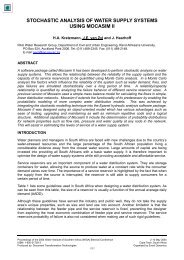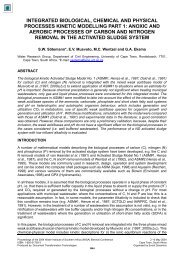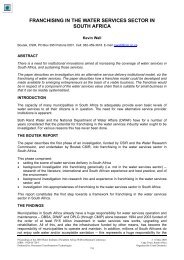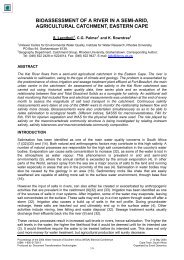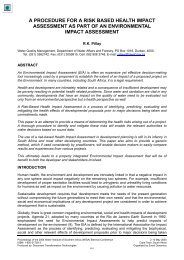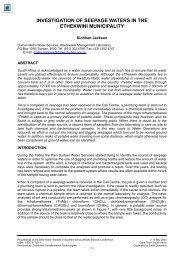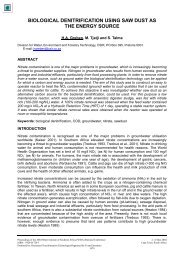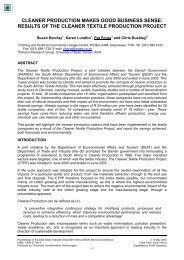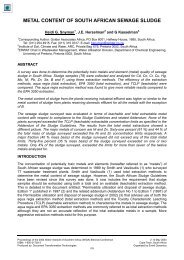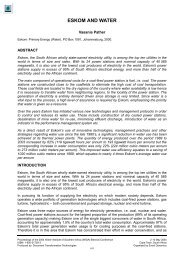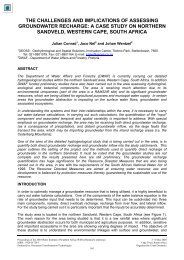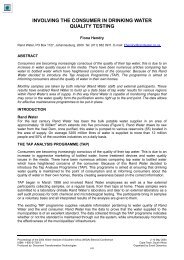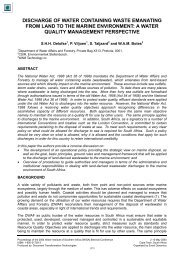The Assessment of “Existing Lawful Use” of Groundwater ... - eWISA
The Assessment of “Existing Lawful Use” of Groundwater ... - eWISA
The Assessment of “Existing Lawful Use” of Groundwater ... - eWISA
Create successful ePaper yourself
Turn your PDF publications into a flip-book with our unique Google optimized e-Paper software.
THE ASSESSMENT OF “EXISTING LAWFUL USE” OF<br />
GROUNDWATER USING REMOTE SENSING AND<br />
GEOGRAPHIC INFORMATION SYSTEMS<br />
Johan Wentzel 1 , Julian Conrad 2 , Abdulla Parker 3 and Bayanda Zenzile 3<br />
1 DWAF - Department <strong>of</strong> Water Affairs and Forestry, Private Bag X313, Pretoria, 0001. Tel: 012-336 8073.<br />
Fax: 012-328 6397. E-mail: wentzelj@dwaf.gov.za<br />
2 GEOSS - Geohydrological and Spatial Solutions, Stellenbosch.<br />
3 DWAF - Department <strong>of</strong> Water Affairs and Forestry, Bellville.<br />
ABSTRACT<br />
<strong>The</strong> Department <strong>of</strong> Water Affairs and Forestry (DWAF) is responsible for the registration and<br />
licensing, if necessary, <strong>of</strong> a number <strong>of</strong> water related issues including the abstraction <strong>of</strong><br />
groundwater. <strong>The</strong> National Water Act <strong>of</strong> 1998 states that water rights that were exercised in<br />
October 1998 are to be considered as existing lawful use. On the receipt <strong>of</strong> applications for further<br />
groundwater abstraction, it is <strong>of</strong>ten stated that a certain volume abstracted is “existing lawful use”.<br />
<strong>The</strong> Department <strong>of</strong> Water Affairs and Forestry needs to be able to verify the claims made and they<br />
are busy determining the most suitable method to carry this out. An approach that is currently<br />
being tested is making use <strong>of</strong> 1998 satellite imagery with remote sensing technologies and<br />
geographical information systems for assessing existing lawful use.<br />
This approach is being tested extensively in the northern Sandveld (Olifants-Doorn Water<br />
Management Area), with good success. However, there are a number <strong>of</strong> critical issues that need<br />
to be taken into account. <strong>The</strong>se issues include the importance <strong>of</strong> ground truthing the current<br />
satellite imagery, the variation in the types <strong>of</strong> crops used, the variabilities associated with the water<br />
sources used for crop irrigation, and the costs associated with acquiring current imagery.<br />
INTRODUCTION<br />
<strong>The</strong> National Water Act <strong>of</strong> 1998 (1) states that water rights that were being exercised in October<br />
1998 would in future be regarded as existing lawful use. This implies that irrigators could continue<br />
their activities unless there is reason to believe that the resource is over allocated. In such an<br />
instance, the Department <strong>of</strong> Water Affairs and Forestry would implement a process <strong>of</strong> Compulsory<br />
Licensing. This process is carried out in conjunction with the irrigators and will not be discussed<br />
further in this paper. If users want to expand their existing activities, requiring increased water<br />
usage, then they must apply for a license to do so.<br />
REGISTRATION<br />
In order to assess the water use situation and to quantify the amount <strong>of</strong> water actually used, a<br />
process whereby all water users were required to register their use was initiated. This information<br />
is needed to assess the current use <strong>of</strong> the water resource and will also be used for billing<br />
purposes. This process is not the same as the licensing process. <strong>The</strong> registration information,<br />
which includes the user’s personal details as well as their water use, was subsequently captured<br />
electronically and a database called WARMS (Water Authorisation and Registration Management<br />
System), was created within the Department <strong>of</strong> Water Affairs and Forestry to manage this<br />
information.<br />
Proceedings <strong>of</strong> the 2004 Water Institute <strong>of</strong> Southern Africa (WISA) Biennial Conference 2 –6 May 2004<br />
ISBN: 1-920-01728-3 Cape Town, South Africa<br />
Produced by: Document Transformation Technologies Organised by Event Dynamics
VERIFICATION<br />
<strong>The</strong> most cost effective way to verify irrigator’s registered usage is by making use <strong>of</strong> colour aerial<br />
photography and satellite images that have been georeferenced and have a high enough<br />
resolution to identify irrigated land with a fair degree <strong>of</strong> accuracy. <strong>The</strong> Department <strong>of</strong> Water Affairs<br />
and Forestry is currently using LANDSAT TM images for the verification process. <strong>The</strong> first<br />
LANDSAT satellite was launched in 1972 and the latest, LANDSAT 7, was launched in April 1999.<br />
Although satellite images taken before 1984 did not have a very good resolution, the images have<br />
subsequently improved enough to allow their use for the verification process. <strong>The</strong> resolution with<br />
LANDSAT 7, for instance is 30 m (multi-spectral) and 15m (panchromatic). Satellite images consist<br />
<strong>of</strong> multi-spectral bands, where a band is a slice <strong>of</strong> wavelengths from the electromagnetic spectrum.<br />
All objects that reflect green light for instance, will be captured in one band. (<strong>The</strong> colour per se is<br />
not captured, only the frequency). <strong>The</strong>se spectral bands can then be manipulated electronically to<br />
highlight certain features on the earth’s surface, such as centre-pivots.<br />
<strong>The</strong> WARMS database information was linked to the national farm coverage data supplied by the<br />
Department <strong>of</strong> Land Affairs. Figure 1 illustrates farm boundaries superimposed on a LANDSAT 5<br />
image.<br />
Figure 1. A 1998 LANDSAT satellite image showing centre pivots. Farm boundaries are shown in yellow.<br />
By linking WARMS data and using computers to display satellite imagery, one can now select a<br />
particular farm, know immediately who the owner is and view his registration details. Satellite<br />
imagery captures the actual pivots and the area irrigated by the pivot can be calculated. (Since<br />
most crops in this study area are potatoes, calculations carried out presume that the crop being<br />
studied will also be potato). Using known irrigation usages for potatoes (per season), water usage<br />
per pivot can be calculated. Results obtained can then be compared with the value registered by<br />
the farmer. Figure 2 shows a 1998 satellite image with electronically captured centre pivot areas<br />
superimposed. Green circles indicate active circles, and yellow denotes inactive areas. This image<br />
was captured in 1998 and partially reflects the existing lawful use.<br />
In order to quantify the expansion that has taken place since 1998, information obtained from more<br />
recent satellite images has been subjected to the same process as discussed before. Figure 3<br />
illustrates the differences between 1998 and 2002 agricultural activities.
Figure 2. GIS captured irrigation areas, classified according to irrigation. <strong>The</strong><br />
1998 image provides an assessment <strong>of</strong> “existing lawful use”.<br />
While pink circles appeared on the 1998 satellite images, all circles coloured green have been<br />
developed since then. As described before, having linked the WARMS database to Department <strong>of</strong><br />
Land Affairs information, it is possible to identify farms where expansion has taken place. If<br />
follow-up investigation finds no justification for the expansion, the irrigator will be requested to stop<br />
his activities immediately or face prosecution.<br />
DISCUSSION<br />
Figure 3. Agricultural expansion subsequent to 1998 (indicated by the green circles).<br />
DWAF are currently receiving more and more reports <strong>of</strong> the illegal development <strong>of</strong> irrigation and<br />
building <strong>of</strong> unauthorised dams in all parts <strong>of</strong> the country (Wessels, 2003) (2) . DWAF is obliged to<br />
follow up on these reports and legally sound procedures have been developed for this purpose.<br />
<strong>The</strong> key activities are verification <strong>of</strong> registered water use and verification <strong>of</strong> existing lawful water<br />
use. <strong>The</strong> verification <strong>of</strong> water use registration is the initial process. This involves an audit <strong>of</strong><br />
WARMS data and using appropriate remote sensing data / maps / aerial photography or any other<br />
relevant information. Verification <strong>of</strong> existing lawful use is a more complex process and fraught with
practical, legal and technical consequences. DWAF’s Directorate <strong>of</strong> Water Utilisation is well aware<br />
<strong>of</strong> these consequences and is currently developing procedures and directives for dealing with the<br />
verification process. A flow diagram is included (Figure 4) <strong>of</strong> the proposed procedures and the<br />
required documentation developed (i.e. letters 1 to 5 in Figure 4) should there be non-compliance<br />
issues.<br />
Yes<br />
•Satellite imagery<br />
•Aerial Photos<br />
•Reports from area<br />
•Departmental <strong>of</strong>ficials<br />
set 35(3)(b)<br />
Sufficient<br />
information<br />
Letter 1<br />
Yes<br />
Determine extent<br />
and lawfulness<br />
sec 35(4)<br />
Possible unlawful<br />
water use<br />
Notice to user to apply<br />
for Verification<br />
sec 35(1)<br />
No<br />
Letter 3<br />
Was application<br />
received in time<br />
sec 35(2)(c)<br />
Yes<br />
Request additional<br />
information<br />
sec 35(3)(a)<br />
Yes Is existing<br />
No<br />
use lawful?<br />
Confirm existing<br />
lawful use<br />
Note<br />
Indicates written<br />
actions requiring<br />
standard documents<br />
Yes<br />
Letter 5<br />
Letter 2<br />
No<br />
Late application<br />
condoned<br />
sec 35(6)<br />
•Application form<br />
•Return date<br />
•Entitlement w ill lapse if no<br />
application received<br />
•Deliver personally or registered mail<br />
sec 35(2)<br />
No<br />
Inform user to stop<br />
water use<br />
sec 35(5)(a)<br />
Give applicant opportunity<br />
to make representations<br />
sec 35(3)(d)<br />
Was the<br />
representation<br />
successful<br />
No<br />
Issue directive to stop<br />
unlawful use<br />
sec 53(1)<br />
Letter 4(a)<br />
Letter 4<br />
Figure 4. Flow diagram <strong>of</strong> procedures and actions to be followed in the verification <strong>of</strong> existing<br />
lawful water use.
<strong>The</strong> described method in this paper is currently the most cost effective way to verifying water<br />
usage and <strong>of</strong> keeping pace with continuing development. It must be noted that in the study area a<br />
single crop type predominates and the assumption is made that all irrigated areas are for potatoes.<br />
<strong>The</strong> irrigation requirements for potatoes are known for different times <strong>of</strong> year and the amount <strong>of</strong><br />
water being applied can thus be calculated. No testing was carried out to see if crop types could be<br />
differentiated and identified. In addition, there are typically two growing seasons for potatoes per<br />
year and this issue must be kept in mind. <strong>The</strong> land after a potato harvest is then left fallow for 3 to<br />
5 years. Thus a single image only provides data for a particular time and extrapolation <strong>of</strong> the active<br />
crop areas and water consumption to an annual figure must be carried out carefully. At least two<br />
images per year (ideally six months apart) should be assessed to determine annual figures.<br />
Although Landsat TM was used there are a number <strong>of</strong> other sensors and images that can be used<br />
and further investigation should be carried out to determine the most cost effective solution for<br />
addressing the assessment <strong>of</strong> existing lawful use and current status.<br />
CONCLUSION<br />
Based on the procedures and directives developed by DWAF’s Directorate <strong>of</strong> Water Utilisation, and<br />
the testing being carried out in pilot areas across South Africa, including the northern Sandveld,<br />
Olifants-Doorn Water Management Area, the continued illegal use <strong>of</strong> water for irrigation purposes<br />
and the building <strong>of</strong> unauthorised dams will be addressed, challenged and terminated. <strong>The</strong>se<br />
activities need to be particularly swiftly dealt with in the “stressed” dry regions that are currently<br />
widespread throughout South Africa.<br />
REFERENCES<br />
1. DWAF, <strong>The</strong> National Water Act (Act 36) (1998).<br />
2. J.J. Wessels, Briefing notification <strong>of</strong> registered water use and procedure for dealing with<br />
unauthorised water use. DWAF Internal Communication. File B191/1 (2003).



